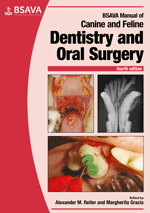
Full text loading...

Extraction of teeth (exodontics) is one of the most frequently performed procedures in small animal practice. Utilizing good instrumentation and applying proper techniques can help to provide a stress-free and controlled procedure. Operative Techniques: Maxillary canine tooth extraction in the dog; Mandibular canine tooth extraction in the dog; Maxillary fourth premolar tooth extraction in the dog; Mandibular first molar tooth extraction in the dog; Extraction of the maxillary canine and cheek teeth in the cat; Extraction of the mandibular canine and cheek teeth in the cat; Crown amputation and intentional retention of resorbing root tissue in the cat.
Closed and open tooth extraction, Page 1 of 1
< Previous page | Next page > /docserver/preview/fulltext/10.22233/9781905319602/9781905319602.12-1.gif

Full text loading...
























































